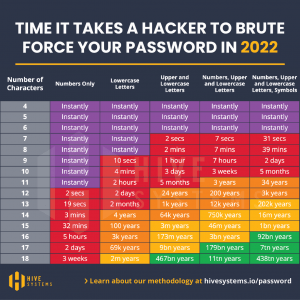How long do you think it would take a hacker to crack your current passwords?
On average, it takes a hacker about 2 seconds to crack an 11-character password that only uses numbers. See the attached chart that illustrates the time it takes for a hacker to brute force attack your password. A brute force attack is when cybercriminals use trial and error to guess your details. Cybercriminals currently use sophisticated software that can run thousands of password combinations in a minute, but their technology and resources are only getting stronger.
A general rule is that your password should be at least 11 characters, utilizing both numbers as well as upper and lowercase letters. That combination will take hackers 41 years to crack. Regardless of the possible variations, the shorter your password, the easier it is to crack. Check out how long it will take a hacker to crack your password at https://www.security.org/how-secure-is-my-password/.
Lastly, simplify and secure your accounts by using a password manager that creates and stores all your passwords for you.

Strengthen your password security with the following tips:
- Prioritize the length and complexity of your passwords.
- Don't use personal information. This can be publicly available and easily accessible by hackers.
- Avoid using dictionary words as passwords. Cracking tools can easily process every word in the dictionary.
- Don't reuse passwords. If one account is breached, your other accounts would be vulnerable as well. Rather, use password managers, which are a convenient and secure way to manage complex passwords on multiple platforms.
- Use multifactor authentication (MFA or 2FA) for especially sensitive accounts.
- Avoid typing passwords while using public Wi-Fi. Instead, use a VPN or avoid websites that require your login information.

